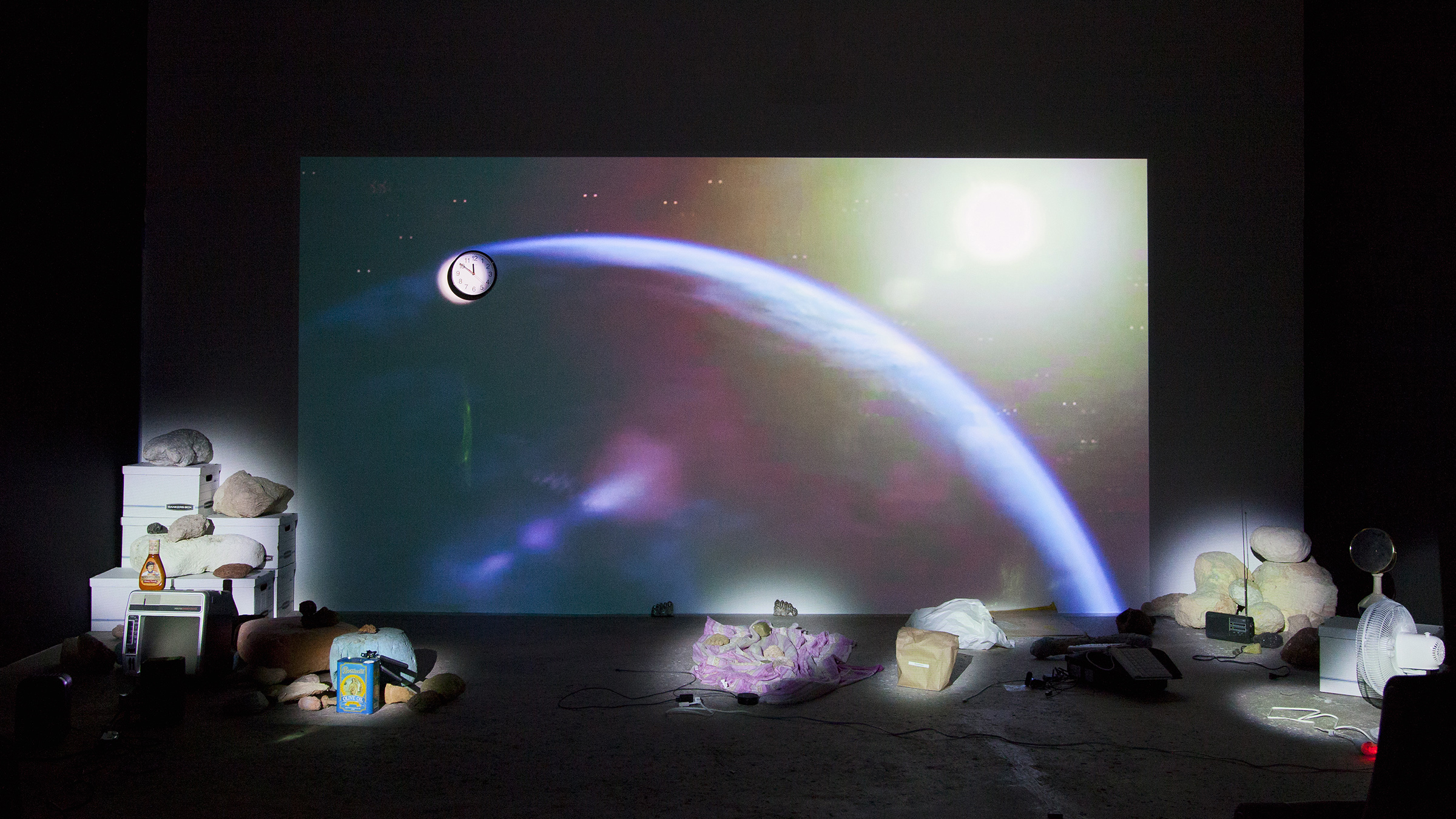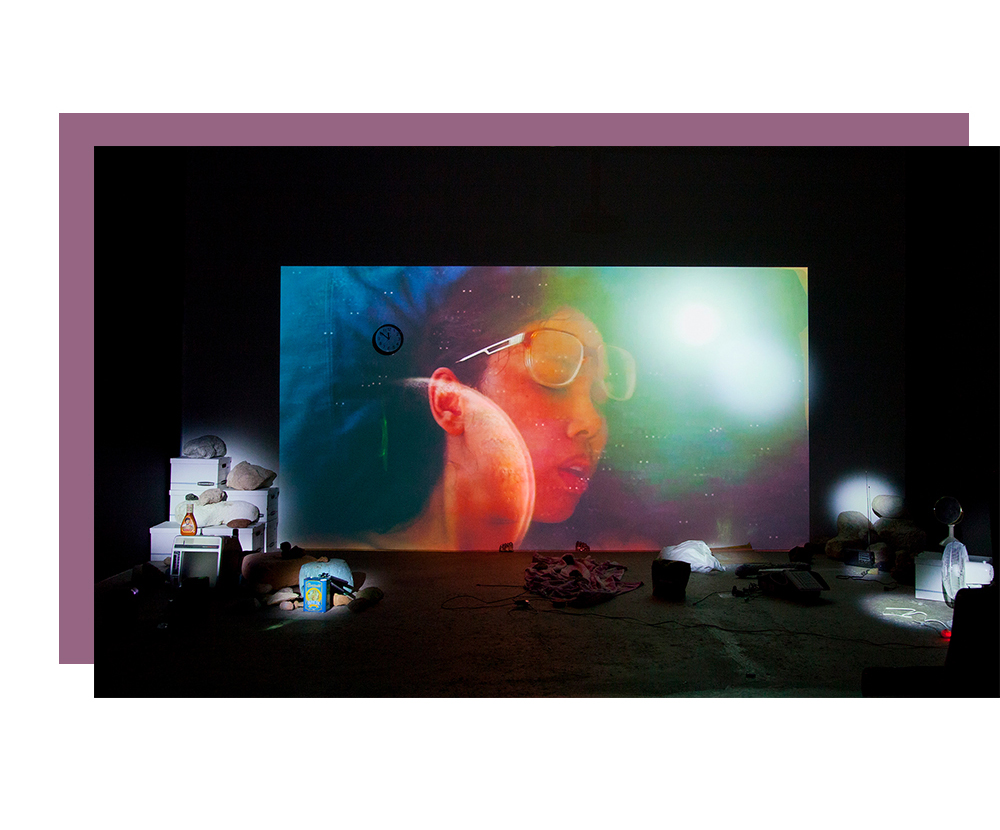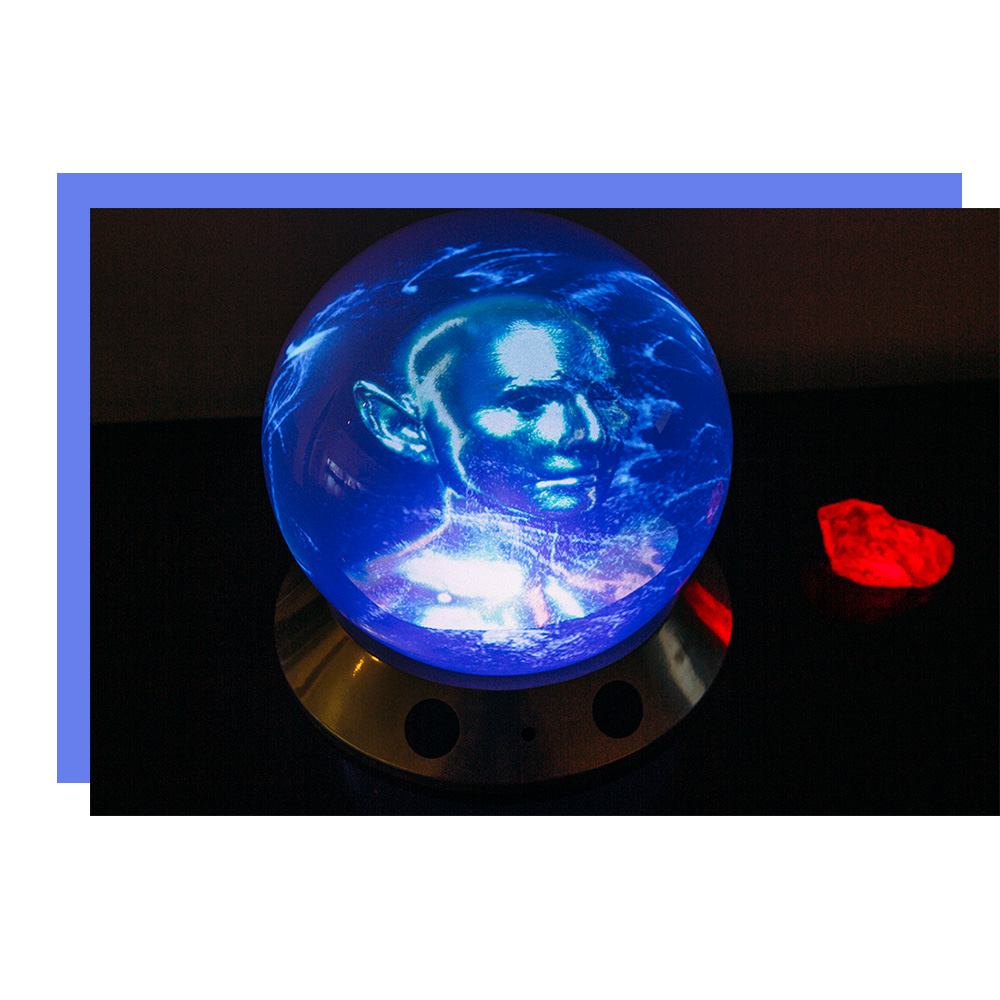Mon June 30th Closed
The Body Electric

“Long live the new flesh,” utters James Woods’s character, Max Renn, in the final scenes of David Cronenberg’s Videodrome (1983), a meditation on the merging of human desires, TV screens, and mass media. Throughout the film, flesh and screen are one—at one point Renn’s chest turns into a VCR; at another a veiny skin envelops a gun protruding from the TV set. Permeating Videodrome is a mindless consumption of imagery and a constant cycle of violence, sex, and destruction—all negotiated vis-à-vis the screen. Almost four decades later, Videodrome gathers renewed salience given the omnipresent screens of our lives—phones, tablets, computers—and the endless stream of scrolling and swiping through media content that seamlessly blends images of war, desire, and sex. What defines our relationship to the space of the screen? How do we negotiate ourselves and others via technology? How do artists respond to a shifting technological landscape in relation to identity and embodiment?
“What defines our relationship to the space of the screen?”
Though not organized chronologically, The Body Electric is anchored in the mid-1960s and such artists as Nam June Paik, Charlotte Moorman, Shigeko Kubota, and Wolf Vostell, who were the first to employ TVs as both the subject and the material of their work. Given today’s continually cheapening technologies, it might be challenging to appreciate the radicality of this generation’s actions. In the 1960s, US television ownership reached new heights and the TV was at the very center of home life, at once a platform for entertainment and a conduit for ideology. For these artists, activating TVs with ephemeral actions both subverted their symbolism and broke down the disciplinary boundaries separating performing and visual arts. For Vostell, events were “weapons to politicize art,” and his happenings, in which TVs were routinely “desacralized” by being encased in concrete or buried, raised questions about the role of technology in everyday life.1 It is effectively a sculpture today, but Nam June Paik’s TV Cello (1971) was originally an instrument for Charlotte Moorman, whose movements would alter the imagery on its screens. Paik’s TV Bra for Living Sculpture (1969) literally fused the technological with the human figure.

Performance pioneers Joan Jonas and Ulrike Rosenbach frequently turned to this exact interstice between technology and the performing body. Jonas’s Funnel (1974/2019) revisits the eponymous performance, which was presented across Germany, Italy and the United States, including at the Walker Art Center, in 1974. During the event, Jonas sang, created drawings on silk, and enacted gestures aided by props including a white rabbit, spinning discs, and a leather belt. Moving within a layered space arranged with paper cones, hanging curtains, and a child’s desk, the artist also appeared on a nearby TV monitor via a live video feed. For Jonas, the installation is a “translation of the performance,” a tableau of props and objects that harken back to the original event.2
“By exploring the space between the performing body and its mediated image, these artists opened new possibilities, not least in regard to interdisciplinary practice, but crucially in terms of representation.”
Similarly, Rosenbach’s Reflections on the Birth of Venus (1975/1978) references a performance of the same title, visible in the life-size projection of the artist posing in front of a slide showing Sandro Botticelli’s The Birth of Venus (ca. 1485). Accompanied by a triangle of salt on the floor and a video of lapping waves within a shell-shaped object, the work explores female identity and, in the artist’s words, speaks to the “cliché for the erotic adaptation of women to the sexual needs of a male world.”3 By exploring the space between the performing body and its mediated image, these artists opened new possibilities, not least in regard to interdisciplinary practice, but crucially in terms of representation.
For many of the artists in The Body Electric, the lens of the camera and the space of the screen offer avenues to explore the politics of the mediated image. The exhibition draws on intergenerational dialogue to reveal common ground, especially in relation to shared concerns with nationality, sexuality, race, and gender. Consider works by Lorna Simpson and Amalia Ulman that investigate how the circulation of the photographic image shapes conventions of femininity and beauty. Simpson’s 1957–2009 Interior #1 (2009) explores the pinup picture by juxtaposing appropriated amateur photos taken in Los Angeles in 1957 with Simpson’s self-portraits that faithfully replicate the setting and poses of the originals. The images dialogue over five decades to question how clothing, skin color, hair, and gender inform our understanding of identity. Ulman’s Excellences and Perfections (2014) brings the vintage pinup into the contemporary moment not via the format of a magazine, but using the social networking service Instagram, for which the series was conceived. For this performance, Ulman took on the persona of an urbanite beauty blogger, crafting a Pinterest mood-board-worthy feed of lifestyle images (shopping-spree selfies, champagne brunches, et cetera). Social media users interacted with Ulman without realizing the staged nature of her imagery, some lambasting a perceived vapidity, others dripping with flattery. Whether turning to amateur photography, printed magazines, or social media platforms, Simpson and Ulman question how we understand the female self in relation to mass media.

Martine Syms has frequently cited the cultural historian Alison Landsberg in this regard, in particular her conception of “prosthetic memory.” Landsberg’s term proposes that in today’s media-saturated landscape, we understand our own identity in relation to a common “prosthetic memory”4 that transcends the boundaries of social class, gender, or race. This sense of memory is rooted not in lived experience, but in our shared familiarity with cultural texts such as films and books, but also GIFs, Vine videos, and memes. Syms’s Notes on Gesture (2015) addresses this idea through the visual language of looped GIFs. The video shows the artist Diamond Stingily repeating a number of authentic and dramatic gestures that each relate to African American women: “famous women, infamous women and unknown women,” as Syms has said.5 Inspired by English philosopher John Bulwer’s Chirologia: Or the Natural Language of the Hand,a 1644 thesis on the communicative meaning of hand movements, Syms’s video offers an inventory of gestures, questioning the assumptions we make about a person’s appearance, behavior, and nonverbal communication. Throughout The Body Electric,groupings of artists demonstrate shared engagements with themes of transgender identity (Rhys Ernst and Zackary Drucker, Juliana Huxtable), visualizing queerness (Paul Mpagi Sepuya), and race (Howardena Pindell, Lyle Ashton Harris), speaking to how we negotiate our sense of self in relation to media-driven systems of representation.
In 1986 the performance artist Stelarc wrote, “Skin has become inadequate in interfacing with reality. . . . Technology has become the body’s new membrane of existence.”6 While mostly clunky (think Google Glasses) or still in development (for instance the Cicret, a waterproof bracelet that projects your smartphone system onto your wrist, with the skin as a stand-in for the screen), advances in body hacking and wearables are seeking to make porous the boundary between the body and technology. Many of the artists in The Body Electric dwell on such blurring, moving from the world into the screen and back again. New technologies always necessitate experimentation, and the exhibition includes such milestone works as Simone Forti’s mid-1970s holograms and Peter Campus’s seminal Three Transitions (1973), in which the artist uses chroma-key effects to layer video imagery to create self-portraits.
“Whether turning to amateur photography, printed magazines, or social media platforms, Simpson and Ulman question how we understand the female self in relation to mass media.”
Several of the artists on view engage with avatars as a means to extend the self into virtual space. In Lynn Hershman Leeson’s first interactive video installation, Deep Contact (1984–89), viewers engage with Marion, the work’s “guide,” by pressing images of her body parts on a touch screen, each corresponding to different narrative possibility. The erotic association of intimacy with technology promises an ambiguous and voyeuristic encounter that raises questions about the objectification of femininity in digital media. A more sorrowful tone fills Pierre Huyghe’s Two Minutes Out of Time (2000), in which the manga character Annlee describes her existence. Though originally likely destined to be merely a background character, she has been “waiting to be dropped into a story” and appears “animated . . . not by a story with a plot [but] haunted by your imagination.” While at first her voice seems to be that of an adult, it quickly changes to a tense tone of a young girl, who describes viewing a painting of water lilies and disappearing into a strange light (the voice, in reality, is an altered recording of a five-year-old girl to whom Huyghe showed the manga picture and asked how she might respond if she knew that the character had only two minutes to live).
It is odd how tender characters such as Annlee, or the somewhat hungover protagonists of Ed Atkins’s works, may seem. Atkins’s video Happy Birthday!!! (2014) features a highly realistic CGI character voiced by the artist. Mumbling through a seemingly arbitrary list of years, days, and time codes, he appears to be struggling to remember a significant past event. As he searches through his “memories,” various collaged imagery —swirling CGI animations, the night sky, a bedroom—plays against pathetic, heart-wrenching music, such as Elvis Presley crooning “Always on My Mind.” Atkins has described Happy Birthday!!! as full of “terrible nostalgia,” an achingly melancholic meditation on memory and mortality.7 It is impossible not to empathize with Atkins’s confused and dazed character, who like Annlee is rooted in the real world. Its CGI likeness takes after a real-life model and was purchased via TurboSquid, a website that supplies 3D stock models for computer games, adult entertainment, and architectural renderings.
These works forge an uneasy relationship between a tangible real-world referent and the infinite possibilities of the screen. Trisha Baga takes her concerns with embodiment and disembodiment to the most cosmic and ethereal extent yet in her immersive installation Mollusca & The Pelvic Floor (2018), which originated with the artist seeking to train her Amazon Alexa virtual assistant to respond to the prompt “Mollusca.” Crisscrossing between appropriated imagery from Hollywood movies (such as Ivan Reitman’s Evolution [2001]and Robert Zemeckis’s Contact [1997])and video shot by the artist in Sicilian caves and Filipino rice paddies, the installation densely layers physical and digital spaces, projected images, and handmade objects to ponder interspecies mingling, metamorphosis, contacting extraterrestrial life, and the future of the human species.

The accelerated rate of technological change frequently outpaces the opportunity for ethical checks and considerations. “Nosedive” (2016), an episode of the dystopian science-fiction TV series Black Mirror, portrays a world where every social exchange is rated and contributes to a person’s ranking. The episode shares much in common with the Chinese Social Credit System, a program set to be fully implemented in 2020 whereby artificial intelligence and mass surveillance monitors and scores citizens based on their social interactions and consumer habits. Sondra Perry’s Graft and Ash for a Three Monitor Workstation (2016) speaks directly to such questions of control and biases inherent in technology. The sculpture consists of a modified bike workstation fitted with three TV screens. Such office furnishings queasily reinforce the glorification of capitalist productivity: the worker not only performs their role, but also works out, toning their fit body. A story unfolds on the screens, narrated by Perry’s own avatar, describing the limitations of the software that rendered her into being: “It could not replicate her fatness. . . . Sondra’s body type was not an accessible preexisting template.” Any humor inherent in the avatar’s deadpan delivery quickly dissipates when considering the problems that people of color face in relation to new technologies. Several studies have shown that facial recognition software used by US police disproportionally selects nonwhite individuals, while even mundane appliances such as automatic soap dispensers are unable to recognize darker skin tones. The work of artists such as Perry, as well as activist sites (such as the World White Web, a website that draws attention to the dominance of white bodies on the internet), gathers a politicized significance given the rise of discriminatory and racist technologies.
Sidsel Meineche Hansen questions how new technologies are changing our approaches to sex and desire. Spurred by a 2014 ruling by the British Board of Film Classification that restricted the showing of certain acts (such as female ejaculation) in pornography produced in the UK, Hansen created DICKGIRL 3D(X) (2016), a work that features EVA v3.0, a royalty-free avatar that the artist purchased through TurboSquid. The hypersexualized CGI animation shows the character fitted with genital props and interacting with an amorphous figure, her movements motion-captured from pornographic films. Hansen deliberately chose to generate DICKGIRL 3D(X) in VR to engage with “post-human porn production from within,” harnessing the very technology that the porn industry is currently most aggressively investing in.8

Commissioned especially for The Body Electric, Zach Blas’s Icosahedron critiques rapidly advancing technologies of prediction. These include not only consumer analytics (for instance the algorithms that generate suggestions on your Amazon and Netflix accounts), but also predictive policing (think of the mutated human “precogs” of Philip K. Dick’s The Minority Report [1956], who psychically visualize crimes before they happen). The installation, Blas says, is a satirical take on what Peter Thiel’s work desk might look like. Thiel, an entrepreneur and venture capitalist, is the cofounder of Palantir Technologies, a data analytics company that takes its name after a crystal ball in J. R. R. Tolkien’s Lord of the Rings (1954), which allows its owner to both communicate from afar and see future events. The business also problematically lays Tolkien’s fantastical geography over that of the real world, forging questionable correspondences, for example between the Middle East and the evil realm of Mordor, effectively vilifying a majority-Muslim sociopolitical context. Blas nods to how such companies structure their work around play, magic, and fantasy through elements in the installation: for instance a glowing philosopher’s stone (an alchemical substance that not only turns metals into gold, but guarantees its possessor immortality) and a crystal ball within which “lives” a free-floating artificially intelligent elf that predicts the future of prediction. The work’s title—Icosahedron—references the twenty-sided die inside the fortune-telling Magic 8-Ball toy, and points to the interactive elf who has been trained on a limited set of twenty writings by such philosophers and fiction writers as William Golding, Ayn Rand, and Yuval Noah Harari (their books can be found on the desk) to respond to visitors’ questions about the future. Though deeply engaged with contemporary politics (at the time of writing, Palantir Technologies faces protests over their software contracts with US Immigration and Customs Enforcement), Icosahedron is also a send-up. The work is purposefully infantile—given its limited number of source texts, the elf is actually quite dumb. It critiques, in Blas’s words, the “childish masculinity and bravado” of entrepreneurs like Thiel.9
“Whether making art, publishing, or in her role as a cofounder of Canaries (a collective of cis women, trans, and nonbinary people living and working with chronic illnesses), Lazard makes visible her ill body to open conversations about how we understand ‘healthy’ and ‘unhealthy.'”
Some of the most recent works in The Body Electric explore health and treatment—issues particularly pertinent today given the ongoing politicization of health care, such as the wrangling over the Affordable Care Act in the United States and the rising threat of privatization of the British National Health Service. It is unsurprising that artists turn to these topics at a time of heightened institutional scrutiny and scandals such as those over Purdue Pharma opioids and water contamination in Flint, Michigan. Made for Instagram, Carolyn Lazard’s series In Sickness and Study (2015–ongoing) is informed by the artist’s experience of living with chronic illness and autoimmune disease. Each image shows her holding whatever book she might be reading at the time as she receives her biweekly intravenous iron infusion. Whether making art, publishing, or in her role as a cofounder of Canaries (a collective of cis women, trans, and nonbinary people living and working with chronic illnesses), Lazard makes visible her ill body to open conversations about how we understand “healthy” and “unhealthy.”
Hormonal Fog Machine (Study #1) (2016) by Patrick Staff and Candice Lin speaks to a related concern: how the substances we ingest have the capacity to shift our hormonal balances. The sculpture consists of a hacked commercial fog machine that vaporizes an herbal tincture made of licorice and black cohosh, which when consumed in large amounts may suppress testosterone production. Unpacking the associations by which our bodies become associated with perceptions of gender underpins Staff and Lin’s investigation of botany through a queer lens. Marianna Simnett’s The Needle and the Larynx (2016) also considers the gendered body, but through the format of a fantastical parable told by a young girl who commands a doctor to lower her voice “so that . . . it is closer to the groans outside that keep me turning in the night.” Shot in agonizingly slow motion, the video shows Simnett receiving Botox injections into her larynx, which paralyzes the muscle and lowers the voice, a procedure typically undertaken by men who perceive their voices as not deep enough. For Simnett, the work melts “the borders of what it means to be female”; it is a meditation on how to transgress the conventions that shape our understanding of the body.10
While technology marches on at an irrepressible pace, The Body Electric views these changes skeptically. Through intergenerational and international dialogue, the exhibition looks to common threads and shared concerns, despite each artist having access to differing technology at different times. Certainly Marshall McLuhan’s mantra “the medium is the message” rings true—artists will always respond to new contemporary technologies (photographic, televisual, digital) and seek to challenge and subvert their logic. Yet regardless of how advanced technology might appear, The Body Electric posits the perennial timeliness of questions of identity, embodiment, race, gender, sexuality, and belonging, across eras and generations.
- Artist quoted in “Wolf Vostell,” Flash Art, March–April 1977, reprinted in Flash Art, November-December 1989, 102.
- Joan Simon, “Imagist: Joan Jonas in Conversation with Joan Simon,” Art in America, December 2010, 164.
- Ulrike Rosenbach, Videokunst (Cologne: self-published, 1982), 13, my translation.
- Alison Landsberg, “Memory: The Transformation of American Remembrance,” in New the Age of Mass Culture (New York: Columbia University Press, 2004).
- Amy Sherlock, “25 Artworks: Martine Syms ‘Notes on Gesture,’” Frieze, issue 181, September 2016, 132
- Stelarc, “Beyond the Body: Amplified Body, Laser Eyes, and Third Hand” (1986), in Theories and Documents of Contemporary Art: A Sourcebook of Artists’ Writings, ed. Kristine Stiles and Peter Selz (Berkeley: University of California Press, 1996), 430
- Ed Atkins speaking about his solo exhibition at Kunsthaus Bregenz, Austria, 2019, https://www.youtube.com/watch?v=laVhwIV-Nyk.
- Exhibition announcement for Sidsel Meineche Hansen, SECOND SEX WAR, Gasworks, London, posted March 14, 2016, https://www.e-flux.com/announcements/44577/sidsel-meineche-hansen-second-sex-war/.
- Zach Blas and Jennifer Rhee, “Toying with the Future: AI, Fantasy, and Zach Blas’s Icosahedron,” Walker Reader blog, June 26, 2019, https://walkerart.org/magazine/icosahedron-zach-blas-jennifer-rhee.
- Jessica Heron-Langton, interview with Marianna Simnett, “Artist Marianna Simnett Explains Her Uncomfortable New Film for Channel 4’s Random Acts,” Dazed Digital, March 11, 2018, https://www.dazeddigital.com/beauty/body/article/42075/1/the-needle-the-larynx.



